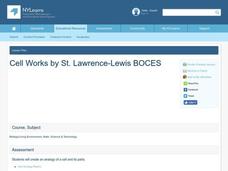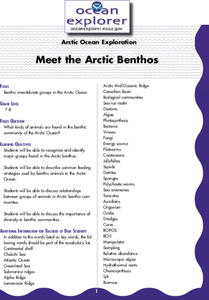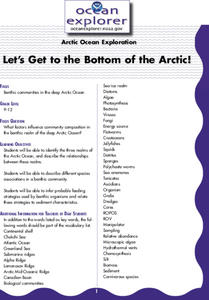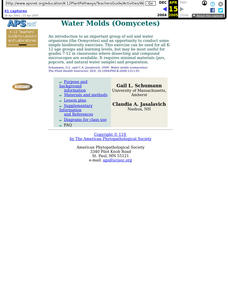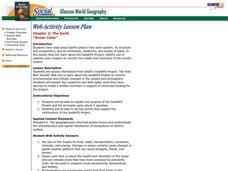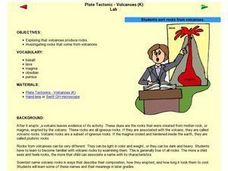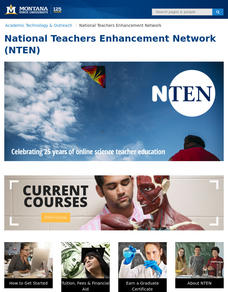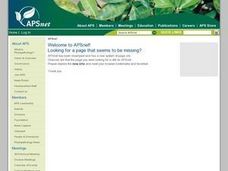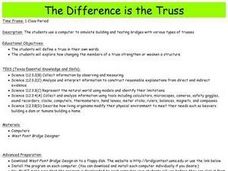Curated OER
Great Salt Lake
Third graders are introduced to the Great Salt Lake (GSL) environment and the various components of it. They make observations about algae and its environment and discuss why it is considered a living organism and various components of...
Curated OER
How Clean Is Our Water?
Students examine samples of water to determine its cleanliness. They visit a waste treatment plant and/or reservoir. Students explore what protects the water supply from contamination by chemical or organize pollution. They trace the...
Curated OER
Microworlds in Waterways Around You Home
Learners explore the concept that different waterways support different organisms. After completing experiments, students predict what life-forms exist in each waterway in their area. They research how humans impact the habitat of other...
Curated OER
DRY UP BABY ! ANHYDROBIOSIS (freeze drying)
In this lab, students explore how organisms are able to survive the extreme environmental conditions found in the Polar regions. Students observe and draw active living rotifers and Tardigrades, design and perform experiments to collect...
Curated OER
Wacky Water Critters
Students recognize the biodiversity that exists in a wetland ecosystem. They identify individual wetland organisms. Students define, identify, and comprehend the importance of adaptations. They describe the process of metamorphosis.
Curated OER
Bacterium Cells
In this bacteria instructional activity, students read several elements of bacterium cells, their diet, types, locations, reproduction, resting stages, effects of, and classification. Students also study a cross-section of bacterium cells.
Curated OER
Polarized Light
Young scholars examine polarized light and that it can be done through reflection. In this reflection lesson students develop a model that accounts for differences in light behavior.
Curated OER
Polarization
Eighth graders study the basic facts of polarization. In this light waves lesson students demonstrate some activities illustrating interference patterns.
Curated OER
Cell Theory, Plant And Animal Cell Comparison
Tenth graders study plant and animal cells. In this investigative lesson students draw their own animal cells and label them.
Curated OER
DNA Blueprint for Life
Students isolate DNA from different food sources. In this biology instructional activity, students research DNA extraction. They analyze DNA stands collected from the lab, and compare the differences between each.
Curated OER
Cell Works
Students identify the different parts of the cells and their functions. In this biology lesson, students create an analogy of a cell and its organelles. They make a poster and present it to class.
Curated OER
There Are Algae in Your House!
Students demonstrate that, although we sometimes can neither smell nor taste them, many ingredients in our foods and household products come from the sea. They also investigate food eat to determine algae derivatives they contain.
Curated OER
Meet the Arctic Benthos
Students recognize and identify major groups found in the Arctic benthos. They describe common feeding strategies used by benthic animals in the Arctic Ocean. They discuss relationships between
Curated OER
Let's Get to the Bottom of the Arctic!
Pupils identify the three realms of the Arctic Ocean, and describe the relationships between these realms. They describe different species associations in a benthic community.
Curated OER
Water Molds (Oomycetes)
Students research a group of fungus-like organisms; the Oomycetes, by baiting them from natural sources (water and soil) and observing them.
Curated OER
Ocean Color
Young scholars examine NASA's SeaWiFS Project Web site to explore how the SeaWiFS Project monitors environmental and climatic changes in the oceans and atmosphere. They answer questions and write a summary in support of continued funding...
Curated OER
Traditional Uses of Wood
First graders explore properties of wood used to make cultural items and make a ring and stick game.
Curated OER
Cells
Third graders investigate yeast to extend their understanding of living and non-living things.
Curated OER
Life in Streams and Ponds
Students collect microorganisms, demonstrate correct laboratory/Gram stain procedure, and design and construct tables to organize data.
Curated OER
One Square Foot
Students identify, describe, count, tally, and graph life found in one square foot of land.
Curated OER
Water Molds (Oomycetes)
Students explore a group of fungus-like organisms; the Oomycetes, by baiting them from natural sources (water and soil) and observing them.
Curated OER
Galloping Who?
Third graders do an Internet search to find out about Galloping Gertie and what caused the bridge to fail.
Curated OER
The Difference is the Truss
Students use a computer to simulate building and testing bridges with various types of trusses.
Other popular searches
- Compound Microscopes
- Dissection Microscopes
- Biology Lab Microscopes
- Scanning Electron Microscopes
- Cheek Cells and Microscopes
- Lesson Plan on Microscopes
- Lenses and Microscopes
- Microscopes and Cells
- Forensics and Microscopes
- Microscopes and Water
- 18 Century Microscopes
- Light Microscopes












